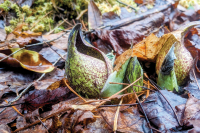Cherokee knew how to handle the chill of winter
 “Two or more Families join together in building a hot-house, about 30 feet Diameter, and 15 feet high, in form of a Cone, with Poles and thatched, without any air-hole, except a small door about 3 feet high and 18 Inches wide. In the Center of the hot-house they burn fire of well-seasoned dry-wood; round the inside are bedsteads sized to the studs, which support the middle of each post; these Houses they resort to with their children in the Winter Nights.”
“Two or more Families join together in building a hot-house, about 30 feet Diameter, and 15 feet high, in form of a Cone, with Poles and thatched, without any air-hole, except a small door about 3 feet high and 18 Inches wide. In the Center of the hot-house they burn fire of well-seasoned dry-wood; round the inside are bedsteads sized to the studs, which support the middle of each post; these Houses they resort to with their children in the Winter Nights.”
— John DeBrahm, “Report of the General Survey in the Southern District of North America,” ed. Louis de Vorsey, Jr., (Univ. of South Carolina Press, 1971)
As I look out my window this morning (Jan. 27) a light snow covers the ground and the temperatures are in the mid-20s. Very picturesque … not life-threatening. Farther north in the Mid-Atlantic states and New England a raging blizzard is wreaking havoc.
Making it through winters here in the Smokies region isn’t that big a deal. The lower elevations where most live don’t normally get a lot of snow and the temperatures only occasionally dip below zero. However, once you get as far north as Boone or Blacksburg, Va., that scenario starts to change drastically.
The early Cherokees were no doubt very much aware of this situation and located their settlements in the southernmost areas of the Appalachians rather than farther north where the climatic stresses would be much greater.
Even so they were and are a cold-hardy people. Charles Hudson, author of The Southeastern Indians (Knoxville: Univ. of Tennessee Press, 1976), noted that, “Although the winter temperatures drop below freezing in the Southeast, the Indians wore relatively little clothing ... and when they were outside they made it a virtue to tolerate being cold and wet.”
Related Items
According to Jefferson Chapman’s Tellico Archaeology (Tennessee Valley Authority, 1985), pre-historic Cherokee domestic buildings in the Smokies region were of three types: a small winter house; a rectangular (often open-sided) structures attached to the winter house, but designed for leisurely summer occupation; and a separate, rather large, rectangular (often partitioned) structure more substantial than summer houses but not as confining as winter houses.
There were also townhouses (often situated atop ceremonial mounds), sweat lodges, storage buildings, menstrual huts, and corncribs. After European contact, the most typical structure was a small, rectangular building that resembled a log cabin and was, indeed, modeled on white pioneer designs.
Theda Perdue described the winter houses (“asi”) in The Cherokees (NY: Chelsea House, 1989) as “small, round, wattle-and daub structures. The fire constantly smoldering in the hearth made the windowless asi dark and smoky.”
Inside the winter houses were raised wooden seats or couches on which the inhabitants or visitors sat or slept. They were, as the Indian trader James Adair observed, “high enough that fleas could not reach them in one jump.”
Each seat/couch was covered with split-cane mats and animal skins. A stone- or mud-lined hole in the center of the structure was excavated as a fire pit.
It was often the duty of the elderly, who remained inside moreso than younger members of the family, to maintain the fire throughout the day and bank it back at night. Fire tending was not an onerous task for the aged but a sign of prestige.
“Europeans who visited these winter houses complained of smoke and poor ventilation, but these buildings were able to maintain heat efficiently,” Hudson noted. “A small blaze or a few coals kept the winter house as warm as an oven. In fact, James Adair described the winter house as being like a ‘Dutch oven.’ Beneath their beds they stored pumpkins, winter squash, and other vegetables to protect them from frost.”
In “Origin and Evolution of the Cherokee Winter House,” published in the Journal of Cherokee Studies (spring 1978), Charles W. Faulkner, a long-time archaeologist at the University of Tennessee, described winter homes excavated in east Tennessee.
Several structures Faulkner labeled “double-oven” winter houses because they were “unique” in that they each contained “two earth ovens on the floor averaging 4.5 feet in diameter and 2 feet deep and filled with limestone blocks that served as a heating and cooking surface.” One of these super structures was “almost 45 feet in diameter with interior ovens 7 feet in diameter and 2.5 feet deep.”
The Cherokees clearly knew when and how to come in out of the cold.
George Ellison wrote the biographical introductions for the reissues of two Appalachian classics: Horace Kephart’s Our Southern Highlanders and James Mooney’s History, Myths, and Sacred Formulas of the Cherokees. In June 2005, a selection of his Back Then columns was published by The History Press in Charleston as Mountain Passages: Natural and Cultural History of Western North Carolina and the Great Smoky Mountains. Readers can contact him at P.O. Box 1262, Bryson City, N.C., 28713, or at This email address is being protected from spambots. You need JavaScript enabled to view it..













